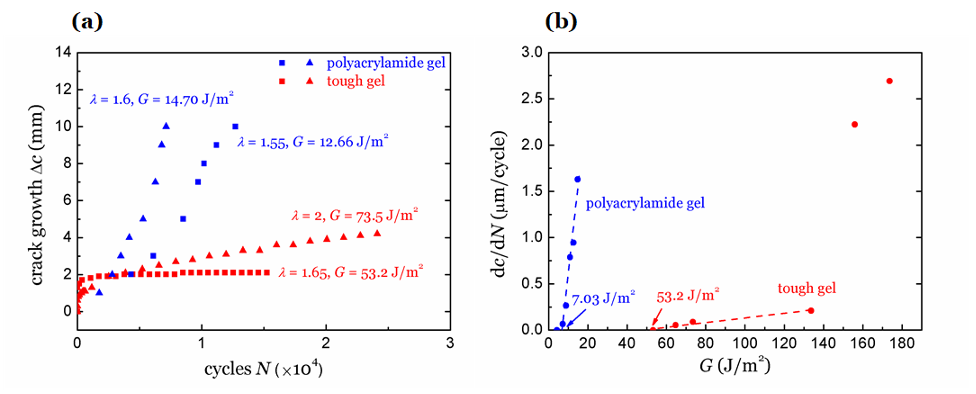Fatigue fracture of tough hydrogels
Ruobing Bai,Quansan Yang,Jingda Tang,Jingda Tang,Xavier Morelle,Joost J. Vlassak,Zhigang Suo +6 more
Reads0
Chats0
TLDR
In this article, the authors studied the fatigue fracture of a polyacrylamide-alginate hydrogel and found that the stress-stretch curve changes cycle by cycle, and reaches a steady state after thousands of cycles.About:
This article is published in Extreme Mechanics Letters.The article was published on 2017-09-01 and is currently open access. It has received 177 citations till now. The article focuses on the topics: Fracture mechanics & Self-healing hydrogels.read more
Figures

Fig. 1 Shakedown after prolonged cycling. (a) A sample of tough hydrogel is cyclically stretched in the pure shear test. (b) The loading profile of the test. Shakedown of stress-stretch curves was observed in tests with different loading frequencies, and shows no significant rate dependence: The loading frequency is (c) 0.25 Hz, (d) 0.125 Hz. 
Fig. 4 Crack growth as a function of the number of cycles N, under different maximum stretches. The crack growth reaches the steady state after thousands of cycles, and becomes approximately a linear function of N. 
Fig. 7 Comparison between a polyacrylamide hydrogel and a tough hydrogel in fatigue fracture. (a) The crack growth of the polyacrylamide hydrogel is faster (steeper slope) than that of the tough hydrogel, even under a less critical condition (smaller and G per cycle). (b) The fatigue threshold of the tough hydrogel is higher than that of the polyacrylamide hydrogel. The slope of dc/dN vs. G in the tough hydrogel is much lower than that in the polyacrylamide hydrogel. Both factors show that tough hydrogels have better fatigue fracture resistance than polyacrylamide hydrogels. 
Fig. 6 (a) A polyacrylamide hydrogel maintains stable stress-stretch loops over thousands of cycles. (b) The maximum stress in each cycle remains nearly constant over cycles. 
Fig. 2 (a) The maximum stress in each cycle decreases and approaches a steady state. (b) The stress-stretch curves after 2000 cycles for different maximum stretches . 
Fig. 5 (a) The energy release rate is calculated by integrating the stress-stretch curve in the steady state of the material far ahead of the crack tip. (b) In the steady state, the extension of crack per cycle, dc/dN, is plotted as a function of energy release rate G. A threshold is found, below which no crack propagation in the steady state occurs. Close above the threshold, dc/dN is found as a linear function of G. dc/dN then increases rapidly with G.
Citations
More filters
Journal ArticleDOI
Hydrogel Adhesion: A Supramolecular Synergy of Chemistry, Topology, and Mechanics
Journal ArticleDOI
Soft Materials by Design: Unconventional Polymer Networks Give Extreme Properties.
TL;DR: In this paper, a review aimed at synergistically reporting: (i) general design principles for hydrogels to achieve extreme mechanical and physical properties, (ii) implementation strategies for the design principles using unconventional polymer networks, and (iii) future directions for the orthogonal design of hydrogel to achieve multiple combined mechanical, physical, chemical, and biological properties.
Journal ArticleDOI
Supramolecular nanofibrillar hydrogels as highly stretchable, elastic and sensitive ionic sensors
Xiaohui Zhang,Nannan Sheng,Wang Linan,Yeqiang Tan,Chun-Zhao Liu,Chun-Zhao Liu,Yanzhi Xia,Zhihong Nie,Kunyan Sui +8 more
TL;DR: In this article, a new class of nature-inspired ionic conductors based on supramolecular sodium alginate (SA) nanofibrillar double network (DN) hydrogels with complex shapes by injection is demonstrated.
Journal ArticleDOI
50th Anniversary Perspective: Networks and Gels: Soft but Dynamic and Tough
TL;DR: A candid and critical overview of the current understanding of the relation between the structure and molecular architecture of polymer networks and their mechanical properties, restricting ourselves to soft networks made of flexible polymers and displaying entropic elasticity.
Journal ArticleDOI
Muscle-like fatigue-resistant hydrogels by mechanical training
TL;DR: A strategy of mechanical training is proposed to achieve the aligned nanofibrillar architectures of skeletal muscles in synthetic hydrogels, resulting in the combinational muscle-like properties, which are obtained through the training-induced alignment of nan ofibrils, without additional chemical modifications or additives.
References
More filters
Journal ArticleDOI
Rupture of rubber. I. Characteristic energy for tearing
R. S. Rivlin,A. G. Thomas +1 more
TL;DR: The resistance to tearing of a rubber vulcanizate is usually determined by loading in a specified manner a test-piece of the vulcanizer of standard shape, in which a notch has been produced, either in the molding process or by cutting the testpiece in a standard fashion.
Journal ArticleDOI
Highly stretchable electroluminescent skin for optical signaling and tactile sensing
Chris Larson,Bryan Peele,Shuo Li,Sanlin S. Robinson,Massimo Totaro,Lucia Beccai,Barbara Mazzolai,Robert F. Shepherd +7 more
TL;DR: An electroluminescent material is presented that is capable of large uniaxial stretching and surface area changes while actively emitting light and is combined in a stretchable electronic material suitable for soft robotics.
Journal ArticleDOI
Softening of Rubber by Deformation
TL;DR: It has been known for many years that deformation results in softening of rubber and that the initial stress-strain curve determined during the first deformation is unique and cannot be re-strained.
Journal ArticleDOI
Multi-scale multi-mechanism design of tough hydrogels: building dissipation into stretchy networks
TL;DR: It is shown that tough hydrogels generally possess mechanisms to dissipate substantial mechanical energy but still maintain high elasticity under deformation, and a particularly promising strategy for the design is to implement multiple mechanisms across multiple length scales into nano-, micro-, meso-, and macro-structures of hydrogel.
Journal ArticleDOI
A theory of coupled diffusion and large deformation in polymeric gels
TL;DR: A theory of the coupled mass transport and large deformation of a polymeric gel, which assumes that the local rearrangement of molecules is instantaneous, and model the long-range migration by assuming that the small molecules diffuse inside the gel.